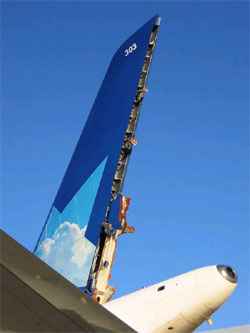KUALA LUMPUR Malaysia's AirAsia today abolished fuel surcharges on all its flights and said it will give away half a million free tickets next year in an attempt to lure travelers amid the global slowdown.
AirAsia Chief Executive Tony Fernandes said the region's biggest budget carrier will offer 500,000 free seats for travel between June 22 and Oct. 24, 2009, on all its domestic and international destinations.
"It will be completely free. Passengers will only have to pay airport tax,'' Fernandes told a news conference.
He said the recent steep drop in fuel prices has allowed AirAsia to adopt the bold strategy, adding that the loss of revenue should be offset by higher ticket sales, which will also be bolstered by new marketing strategies.
 Datuk Seri Tony Fernandes (right) and Datuk Shahrir Abdul Samad at the launch of new low AirAsia air fares on Tuesday. - Starpic by Kevin Tan
Datuk Seri Tony Fernandes (right) and Datuk Shahrir Abdul Samad at the launch of new low AirAsia air fares on Tuesday. - Starpic by Kevin Tan
Fernandes said AirAsia is the first carrier in the world to abolish fuel surcharges, which became a standard industry practice a few years ago as oil prices rose on their way to peaking at nearly $150 a barrel in mid-July. But since then, crude prices have tumbled because expectations that slower global growth will mean less demand.
"We want to do is get rid of these surcharges,'' Fernandes said. "The best way to do it is aggressive marketing and low fares.''
Eliminating the surcharges is expected to cost AirAsia about 940 million ringgit ($63 million) a year.
Fernandes said the move will boost Malaysia's economy as well as domestic and regional tourism by encouraging travel.
When AirAsia started in December 2001, it focused on flying within Malaysia. It has since expanded to Southeast Asia and China, and is scheduled to launch flights to India next month.
Malaysian Domestic Trade and Consumer Affairs Minister Shahrir Samad praised the decision.
"Anything that reduces costs to consumers and keeps money in their pocket gets my support,'' he told reporters after the announcement. "What we need now is optimism instead of grumbling and quarreling.''
Fernandes added that he could not guarantee that the removal of fuel surcharges would not hit AirAsia's profits, but said the company does not anticipate that would happen. He refused to say what the possible losses might be.
He noted AirAsia does not hedge its fuel purchases like other airlines do. To protect against the possibility of prices going up, some carriers make advance orders at current prices.
Fernandes said AirAsia will not implement a corresponding increase in base ticket prices with the removal of fuel surcharges, but said he could not guarantee that the surcharge would not be re-imposed if oil prices surge again.
"It would be foolish of me to say that fuel surcharges will not be imposed again but we will resist it for as long as possible,'' Fernandes said.














































